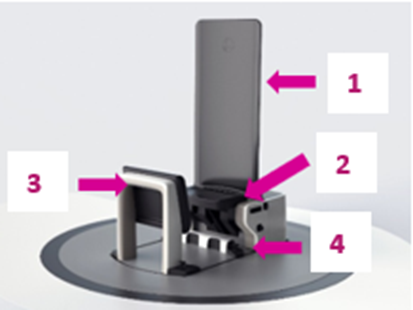Although human beings spend most of their time sitting and standing, radiation therapy treatments are still delivered in supine position. Despite several publications that indicate patient set-up in upright position could be beneficial for their treatment. In this context, a research program on an upright positioning system (the so-called “Chair” developed by the Leo Cancer Care (figure 1)), was initiated. It included three steps:
-patient workflow and immobilization devices development,
-external positioning and immobilization assessment,
-and in the near future, an internal organ position and motion study with a vertical CT scanner.
In this lecture, the first step will be presented for pelvic, head and neck and breast cancer patients; the second step will already be discussed for pelvic cancer patients.
The design thinking theory in healthcare was used to design immobilization devices and define patient workflow. Meetings, workshops and healthy volunteers’ were used to test for results in a “prototype” position. For pelvic cancer patients, the positioning was assessed on sixteen patients treated by radiotherapy in a standard supine position. For that, patients were set-up three times on the chair, i.e. for the first positioning and 2 re-positioning sessions allowing to assess the inter-fraction motion with an optical guidance and tracking system. Intra-fraction motion was evaluated for two 20-minutes Chair rotation sessions, simulating a treatment session. The duration of the first positioning, repositioning and uninstallation were also recorded. A 10-item questionnaire rated from 1 (bad) to 5 (excellent) was designed to assess patient’s comfort in supine and upright positioning.
Regarding patient workflow, we first identified common procedures valuable to setting up patients for any treatment sites. Before patient positioning, backrest angulation (Figure 1, 1), seat pan (Figure 1, 2) and seat height were defined. A 5° backward angle was the most preferred inclination and could be adjusted if needed. The seat pan was defined according to treatment location between sitting position (0°) and standing position (50°). Seat height was adjusted according to the patient leg length. The position of the shin rest (Figure 1, 3) and the heel rest (Figure 1, 4) were defined with the patient, first in standing position and then in the final position. Immobilization devices like head and neck backrest or arm support for pelvic and breast treatments were developed in several steps, and some “standard” immobilization devices like vacuum cushion completed the positioning according to the treatment location. For pelvic cancer, eight women and 8 men treated on regular linacs between October 2021 and June 2022 were included in this assessment. Their median age and weight were 62.5 years (35 to 81 years) and 75.1 kg (41 to 107 kg). The inter-fraction shift means were -0.5 mm (SD= 2.5), -0.4 mm (SD = 1.3) and -0.9 mm (SD = 2.7) in left-right (LR), antero-posterior (AP), and cranio-caudal (CC) directions, respectively. The intrafraction shifts after 20 min were 0.0 mm (SD = 1.5), 0.2 mm (SD = 1.1) and 0.0 mm (SD = 0.3) in LR, CC, and AP directions, respectively. With 2 radiation therapists, on average, 5.0 min (from 4.0 to 5.9 min), 4.9 min (from 3.0 - 9.0 min) and 0.6 min (from 0.3 to 1 min) were required for the first patient’s positioning, their repositioning and their uninstallation. Average global comfort was 4.1 (3 to 5) for the upright position and 3.9 (2 to 5) for the supine position.
This research program validated an upright positioning device for pelvic cancer patient which could be described as easy and fast, and with an excellent repositioning and immobilization accuracy. Patient comfort appeared to be at least as good, sometimes even better compared to supine position. The use of a Chair is a change in paradigm, which opens a potential new direction for the treatment of cancer patients with radiotherapy. Evaluation of breast, thoracic and head and neck tumors is ongoing, and imaging with vertical CT will be added soon.

Figure 1: Upright positioning system developed by Leo Cancer Care